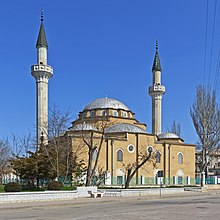The Juma-Jami Mosque, (Ukrainian: Мечеть Джума-Джамі, Crimean Tatar: Cuma Cami, Russian: Мечеть Джума-Джами, Turkish: Cuma Han Camii) also known as the Friday Mosque, is located in Yevpatoria, Crimea.[1] Built between 1552 and 1564, and designed by the Ottoman architect Mimar Sinan.
| Juma-Jami Mosque | |
|---|---|
 | |
| Religion | |
| Affiliation | Islam |
| Rite | Sunni |
| Status | Active |
| Location | |
| Location | Yevpatoria |
| Territory | |
| Geographic coordinates | 45°11′45″N 33°22′38″E |
| Architecture | |
| Architect(s) | Mimar Sinan |
| Type | Mosque |
| Style | Ottoman architecture |
| Completed | 1564 |
| Specifications | |
| Direction of façade | North |
| Dome height (outer) | 20 meters |
| Dome dia. (outer) | 6 m (20 ft) |
| Minaret(s) | 2 |
| Minaret height | 35 meters |
| Materials | Limestone |
History
The Juma-Jami is the largest mosque of Crimea and was founded by Khan Devlet I Giray in 1552. The Khan commissioned Istanbul architect Mimar Sinan (1489–1588) to build the mosque.[2] Sinan was the chief architect of the Ottoman Empire. He designed the Sinan Pasha Mosque and the Şehzade Mosque in Istanbul. Construction of the Juma-Jami Mosque was a long process. At the time, Mimar Sinan was busy with construction of the Süleymaniye Mosque, in Istanbul, which was also plagued by financial difficulties due to money being spent on a war with Ivan the Terrible.
The mosque continued to be embellished and improved over time. From 1740 to 1743, the mosque was rebuilt and the main building was restored; from 1758 to 1769, the western facade of the mosque was decorated with paintings.[3]
Photos
- Main entrance to the Juma-Jami Mosque
See also
References
External links
Wikiwand in your browser!
Seamless Wikipedia browsing. On steroids.
Every time you click a link to Wikipedia, Wiktionary or Wikiquote in your browser's search results, it will show the modern Wikiwand interface.
Wikiwand extension is a five stars, simple, with minimum permission required to keep your browsing private, safe and transparent.






